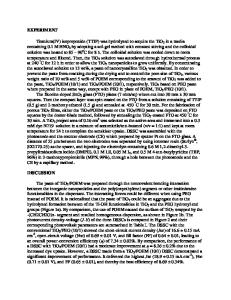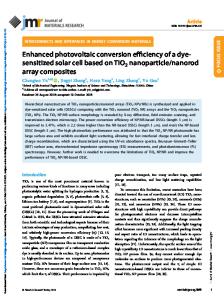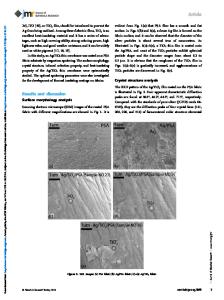Multifunctional Fiber Solar Cell Based on TiO 2 Composite Materials
- PDF / 336,062 Bytes
- 6 Pages / 432 x 648 pts Page_size
- 59 Downloads / 365 Views
Multifunctional Fiber Solar Cell Based on TiO2 Composite Materials Adam Rice1,2, Seong-Ku Kim3, Zuki Tanaka1,2,4, , Dibya Phuya11,3, Xuan Yang1,4, Claire Gu1,4, Qibing Pei3 and Bin Chen1,4 1
NASA Ames Research Center, Moffett Field, CA 94035 2 NASA Research Fellowship Program Department of Electrical Engineering, University of California, CA 95064 4 Department of Materials Science and Engineering, University of California, CA 90095 3
[email protected], 650 6040310
Abstract The paper present a multimode optical fiber based solar lighting and photovoltaic multifunctional device. TiO2, PbS and conducting polymer poly(3-hexylthiophene) (P3HT) were coated on the optical core surface as active photovoltaic layers, with ITO and LiF/Al electrodes. The guided sunlight in the multi-moded fiber was totally internal reflected depending on the incident angle and the evanescent light mode from scattered radiation of light was absorbed by the active layer to generate the electric current. The optical-electrical behaviors such as the short circuit current, filling factor, and open circuit voltage were studied. Furthermore, optical loss and the evanescent field at the interface between the optical fiber core and ITO electrode thin layer was discussed in relation to the coupling light from the guiding medium to the devices. Comparison studies of chemical and physical thin film coating on optical fibers are discussed. In particular, we obtained in situ growth of quantum dot, composite electrolyte and plasmonic enhancement on TiO2. We have demonstrated waveguide like fiber device with photo current measurements and I-V characterizations. Furthermore, we have optimized the device transmission of visible light through total internal reflection, and PV conversion of evanescent light absorbed by solar active composite materials fabricated around optical fibers. Keywords: Composites, lead sulfate quantum dots, titanium oxide nanotubes
Introduction Nanotechnology and nanomaterials have enabled unprecedented device performances in very compact packages of multifunctional materials through device engineering. In particular, composite materials are used in fabricating thin film devices that have multifunctional applications in directly utilizing while simultaneously converting solar energy. Such an optical fiber device requires multiple layers coating onto long strand fibers with a surface of large curvatures. The solution based thin film processes reported here are scalable and low cost fabrication schemes with the precision control of the interfacial interactions of liquid and solid phases. In particular, in situ composite growth and processing is ideal approach for multiple high curvature surface coating in fibers. In this experiment, multimode optical waveguides were used as a guiding medium through total internal reflection and coupling of light into the photovoltaic active region by scattering. Fiber solar cells provide an opportunity to surpass both the efficiency and functionality of traditional flat panel solar cells. These new s
Data Loading...











